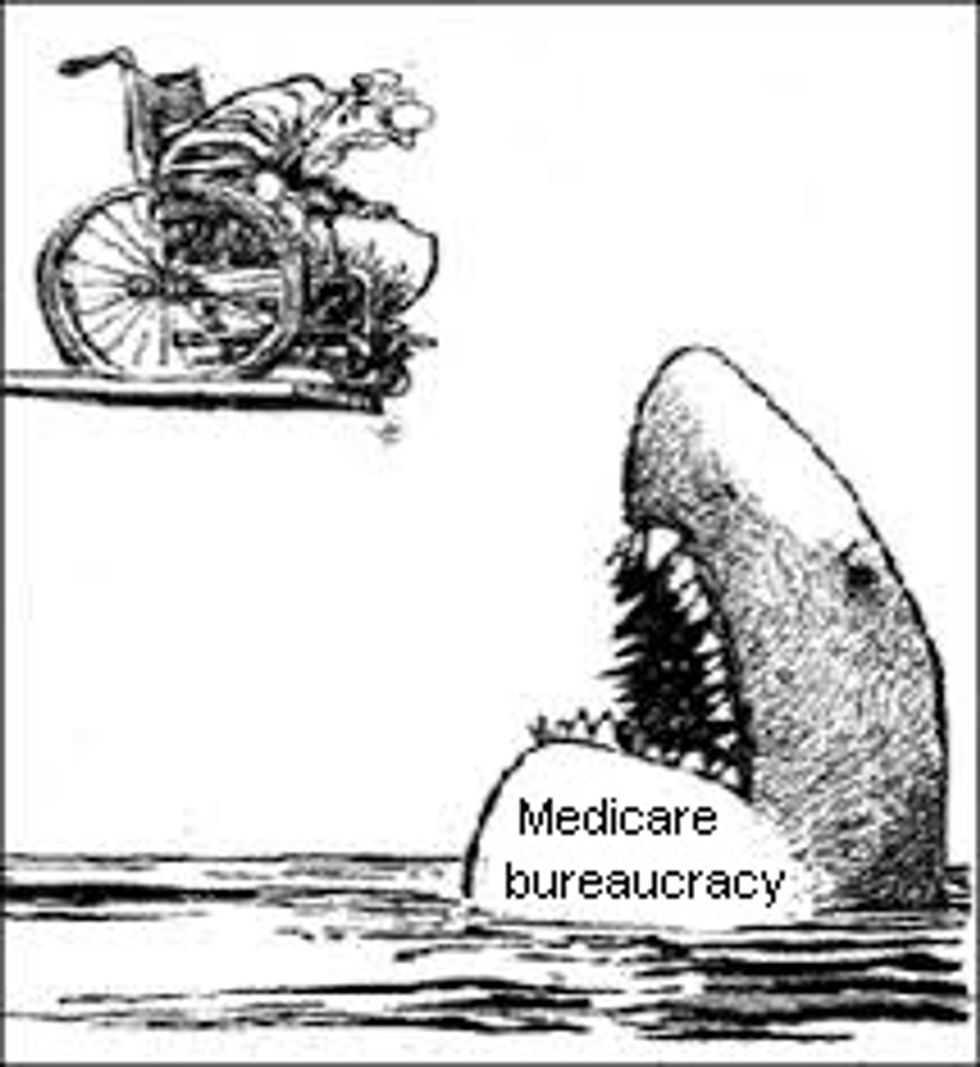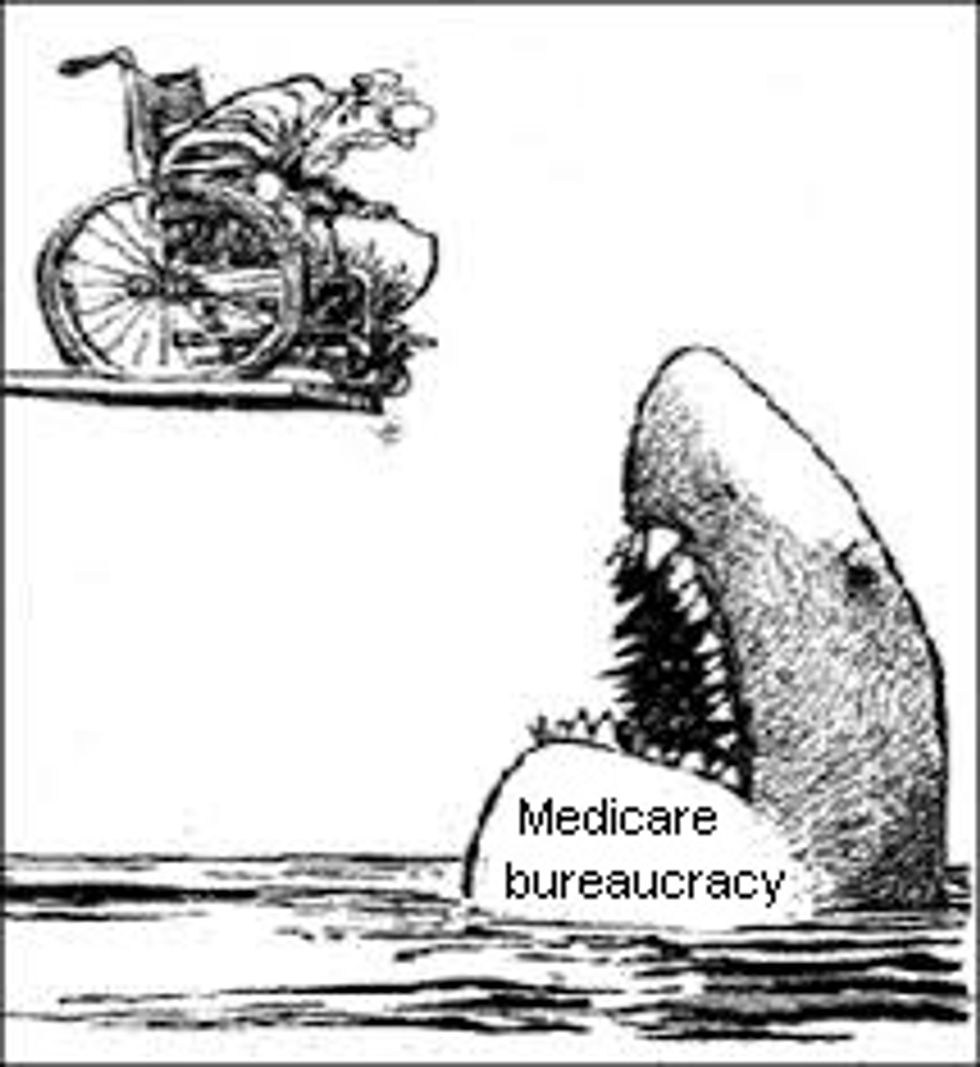
Seniors are "lunch" for Medicare bureaucracy. (Dr. Deane Waldman)

Medicare has been in trouble since it was created in 1965. Its fiscal woes became obvious when the Congressional Budget Office warned in 1996 that the Medicare Trust Fund would be bankrupt by 2015 and would be unable to pay for medical services. The public outcry led to an ill-conceived solution in the Balanced Budget Act of 1997 called the Sustained Growth Ratio.
Congress implemented the Sustained Growth Ratio in 1998 and began to cut payments to doctors who cared for Medicare patients: 600,000 physicians for over 40 million seniors.
These cuts did not solve the Medicare fiscal imbalance. They did, however, exacerbate an already critical doctor shortage just as baby boomers were reaching their golden years. Medicare suffered from both medical woes – limited access to care – as well as a fiscal nightmare of impending bankruptcy.
As noted here at TheBlaze, Congress’ infamous DocFix fixed neither Medicare’s doctor problem nor its economic conundrum. Repeal of both the Sustained Growth Ratio and the DocFix would move us away from fantasyland and closer to reality. These two repeals would not solve either Medicare’s medical dilemma nor its spending imbalance. Congress is currently negotiating various adjustments to Medicare such extended eligibility age, further reductions in reimbursement, or alterations in means-testing. They will not fix Medicare. These modifications will only provide political cover.
[sharequote align="center"]Medicare cannot be fixed. Any promise to save Medicare is more than unrealistic. It is impossible.[/sharequote]
Medicare cannot be fixed. Any promise to save “Medicare as we know it” is more than simply unrealistic. It is impossible. Anyone making such a promise either doesn’t understand first grade arithmetic or is just plain lying.
You don’t need a PhD in Economics from Harvard to know that any system with limited supply and unlimited demand is unstable and cannot survive. That’s like pouring water at a constant rate into a barrel while making the hole at the bottom bigger and bigger. The barrel will soon be empty and you will simply be wasting water.
That is Medicare: increasing demand for services – more people demanding more expensive technologies – paid by a fixed or decreasing supply of dollars. The supply of money for you keeps dropping because more and more dollars are being sucked away from care services to pay for care bureaucracy like Medicare and Obamacare.

Treatments for illnesses that us old folks get – heart disease, arthritis, cancer, and diabetes – are getting better all the time.They are also getting more expensive. Medicare could be saved by medical rationing - restricting medical procedures to less expensive ones. Rationing might “save” Medicare, but rationing will kill seniors, and what is left won’t be “Medicare as we know it.”
We must face facts. Poorly conceived systems – political ones like Soveit Russia or financing schemes such as Medicare – eventually collapse under the weight of their conceptual flaws. Hopefully, Medicare will succumb to Joseph Schumpeter’s creative destruction. Someone will propose a better-designed system, which will by its obvious superiority, replace the ill-conceived plan called Medicare.
Let’s speed things up. Let’s save ourselves. Let’s kill Medicare.
Suppose the federal government counted up all the dollars that each senior citizen contributed to the Medicare Trust Fund over his or her working lifetime. Let’s say that averaged out to $100,000 for each of the 49 million Americans who are now covered by Medicare. That’s how much each person is owed.
Simple math reveals: $100,000 times 49,000,000 people = $4.9 trillion. In 2014, the U.S. spent well over $500 billion on Medicare.
Suppose Washington, D.C. put $10,000 a year for the next 10 years into 49 million Health Savings Accounts, one for each member of the over-65 crowd. That would cost $4.9 trillion over 10 years. The current projection for Medicare spending over the next 10 years is $6.6 trillion, which is considerably more than what this proposed plan would cost.
Seniors could use their money to pay for their care as they see fit. They could shop around and would have a strong incentive to economize, in stark contrast to the federal government. Sellers of medical goods and services would have to compete for seniors’ dollars, driving down the prices enormously. There would be no medical rationing. And most importantly, the government would no longer control your care.
Health Savings Accounts can only be used for medical expenses and for medical insurance. At death, the unused portion would be transferable to a family member of your choice, without being taxed.
Medicare bureaucracy would virtually cease to exist. The public has no idea of the size, reach, and expense of this monster, whose upkeep and growth we unknowingly support.
Medicare’s vaunted dollar-efficiency, “only 3 percent administrative cost,” is a myth. It implies that 97 percent of Medicare dollars go to care. Hogwash! Horsefeathers! B.S.! That ignores all the other costs.
Medicare has a complex, generally incomprehensibly, opaque, and often contradictory structure of rules and regulations; billing and coding procedures and processes; and compliance activities. Think about the costs (that you pay for) of writing, reviewing, interpreting, defending in court, rewriting, and enforcing of millions of pages of 10-point font, single-spaced government mandates.
Under this plan, all Medicare spending would go to health CARE. This would be dollar-efficient spending instead of what we now have: a massively wasteful, dollar-inefficient system that will soon bankrupt itself and take us down with it.
There is a second, even better benefit to a Health Savings Account plan: time with your doctor. At present, care providers waste millions of hours a year – hours they cannot spend with you – reviewing and being tested on worthless study modules on subjects that have nothing to do with improving your health.
To name but a few, there are the latest HIPAA compliance guidelines; “Preparing your own sterile preparations” (we haven’t done that since my grandfather practiced medicine); intricacies of the ICD-10 billing code book (with 148,000 codes: 10 times the number of diseases that affect humans); or latest revision in electronic medical records so now it takes over 20 minutes just to write a prescription for Penicillin.
Not only do you want that doctor-patient time, but so does your provider!
We can save Medicare, not “as we know it,” but create a much better version. A Health Savings Account is an approach to consider and test. It is time for our elected officials to stop using “politically acceptable” as an excuse to avoid doing what is right and necessary for We The People.
Dr. Deane Waldman MD MBA is author of award-winning “The Cancer In Healthcare;” Professor Emeritus of Pediatrics, Pathology and Decision Science; and Adjunct Scholar (Healthcare) for the Rio Grande Foundation, a public policy think tank. Dr. Deane also sits on the Board of Directors of the New Mexico Health Insurance Exchange, as Consumer Advocate. Opinions expressed here are solely his and do not necessarily reflect the opinions of the Board.
–
TheBlaze contributor channel supports an open discourse on a range of views. The opinions expressed in this channel are solely those of each individual author.